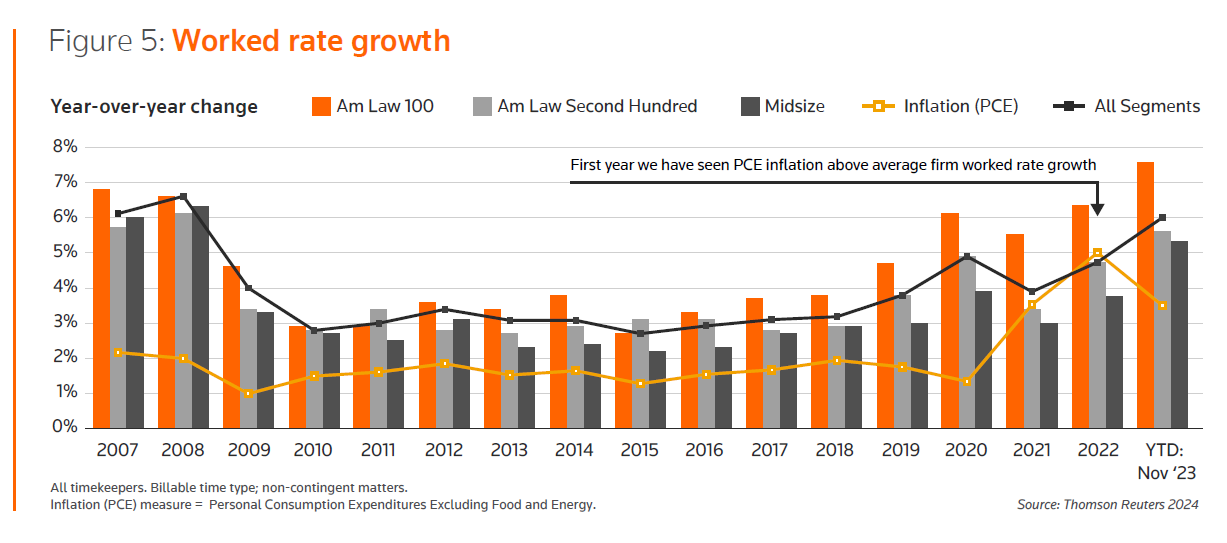Law firms' agreed rates will likely continue to show strong performance in 2024, but there’s going to be more to that story over the coming year
A big part of the story of the US legal market in 2023 was the aggressive pace of growth in the rates clients agreed to pay to engage their outside counsel in new legal work. The growth in this metric, known as worked rates, was expected to be steep, but few predicted just how aggressive firms would be in this area.

Every segment of law firms tracked in the 2024 Report on the State of the US Legal Market experienced worked rate growth that substantially outpaced their 2022 performance. The average Am Law 100 law firm also outpaced their competitor firms in the Am Law Second Hundred and Midsize law firm segments by nearly 2 percentage points. In fact, average worked rate growth for the Am Law 100 was higher even than the pace of rate growth experienced by these same firms prior to the Great Financial Crisis which began to impact the legal market in late 2008.
Aggressive rate growth in 2023 was not a surprising development. Market conditions had hinted that firms could be more aggressive in their rate requests for a few years prior, back to the start of the pandemic in 2020. Moreover, broader economic trends all but necessitated that law firms take a more aggressive posture regarding their rates in 2023. The chart above demonstrates why.
For the entire history of the data, average worked rates enjoyed a comfortable margin above inflation. It’s important to note that growth in law firm rates was not pegged to inflation, but nevertheless, the result remained that law firms typically had a comfortable cushion above one of the forces driving increases in their expenses. However, that cushion disappeared in 2022 as inflation spiked. For the first time, the relationship between average law firm worked rates and inflation actually inverted, giving law firms a basis upon which to seek higher rate increases.
Another interesting phenomenon stood out in 2023. The pace of worked rate growth actually accelerated somewhat throughout the year. Average worked rates grew by 5.5% in Q1, 5.9% in Q2, 6.3% in Q3, before settling at 6.0% through November. At first glance, this might appear that law firms continuously raised rates throughout the year, but that does not appear to be the case.
Negotiating better rates
If law firms were, in fact, raising rates, such a trend would show up not only in worked rates, but in a different metric known as standard rates. This is the measure of growth in the published rate cards of the average law firm. Worked rates, on the other hand, are a function of an agreement between the law firm and its client. Accordingly, growth in worked rates can be the result of more aggressive rate negotiations by the law firm, less price sensitivity by the client, or most often, a combination of both.
In short, clients bear at least some of the responsibility for the increasing scale of worked rate growth throughout 2023. This may be attributable to the fact that, as rates were increasing, clients were simultaneously moving work to lower-cost firms. This, in turn, could impact how aggressively clients negotiate their rates with the new firms winning their work.
Every segment of law firms tracked in the 2024 Report on the State of the US Legal Market experienced worked rate growth that substantially outpaced their 2022 performance.
It’s perhaps easier to explain by way of analogy. There are apps that can help drivers find the best prices for gas in their area. A driver searching for the best price on fuel for their car, whether premium or regular gas, can see reported prices and seek out the best deal. But imagine a driver who has decided that instead of driving the family car that takes premium, instead they will put more miles on the family car that takes regular gas. So, every gallon of regular gas they purchase instead of premium represents a cost savings. It’s not that they won’t still be watching for a good deal, but they are accustomed to paying more for gas due to the fact they’ve traditionally bought premium gas, so they may be less vigilant.
The pricing anchor
Essentially, the driver is anchored to the price of premium gas. What is anchoring? It’s a strategy in which a business establishes a price point for their customers that becomes the customers’ point of reference when making a buying decision. Think of a fast-food value meal. The meal itself has a price, but to upsize the meal costs only a small amount more. The base price of the meal is the anchor, and the upcharge is moderate enough to make a hungry customer feel like they’re getting a lot more value for only a little more money. Not surprisingly, the market is rife with examples of price anchors.
For buyers of legal services that have historically used Am Law 100 firms, the rates charged by those firms are the anchor. For these buyers, it doesn’t really matter to them if the rates being charged by the new Midsize law firm on their roster are 5% higher than that same firm’s rates last year. The rates are still lower than what the client is used to paying from higher-cost firms. Eventually, of course, the new firm’s rates will establish a new anchor point, but that can be a lengthy process.
At the same time, law firms are also establishing new anchors with regard to the pace of rate growth. A few years ago, something in the range of a 3.5% year-over-year increase in the average firm’s rates was the anchor point. The past few years, however, many law firms have shifted that anchor point upwards.
Yet, if worked rate growth reverts back to the pace seen in the 2010s, many industry observers would be quick to wonder why the legal industry had so quickly gone off the rails given the performance of rates in 2023.
And they wouldn’t be wrong to ask this question; however, neither would they be right, necessarily. Even if the pace of rate growth were to revert to status quo pre-pandemic levels, rates would still be growing year-over-year, not shrinking — and law firms would not be charging less. Moreover, it’s questionable how sustainable today’s pace of worked rate growth is. Eventually, it will have to slow.
However, there is really no indication that such a cooling is likely in 2024. The pace of rate growth might be unsustainable long-term, but clients have agreed to them up to this point, with no real display of meaningful pushback. True, realization has declined, but as the report discusses, that has more to do with the law firms themselves than with their clients.
How aggressively rates increase in 2024 will be something we will learn more about in a few weeks as preliminary rate request data becomes available. It’s difficult to know where to set the line on an over/under for the year, however, the smart money would likely take the over side of the wager.







